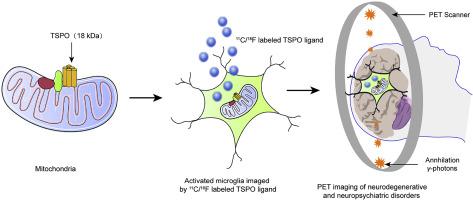Acta Pharmaceutica Sinica B ( IF 14.5 ) Pub Date : 2020-08-25 , DOI: 10.1016/j.apsb.2020.08.006 Lingling Zhang , Kuan Hu , Tuo Shao , Lu Hou , Shaojuan Zhang , Weijian Ye , Lee Josephson , Jeffrey H. Meyer , Ming-Rong Zhang , Neil Vasdev , Jinghao Wang , Hao Xu , Lu Wang , Steven H. Liang

|
The 18 kDa translocator protein (TSPO), previously known as the peripheral benzodiazepine receptor, is predominately localized to the outer mitochondrial membrane in steroidogenic cells. Brain TSPO expression is relatively low under physiological conditions, but is upregulated in response to glial cell activation. As the primary index of neuroinflammation, TSPO is implicated in the pathogenesis and progression of numerous neuropsychiatric disorders and neurodegenerative diseases, including Alzheimer's disease (AD), amyotrophic lateral sclerosis (ALS), Parkinson's disease (PD), multiple sclerosis (MS), major depressive disorder (MDD) and obsessive compulsive disorder (OCD). In this context, numerous TSPO-targeted positron emission tomography (PET) tracers have been developed. Among them, several radioligands have advanced to clinical research studies. In this review, we will overview the recent development of TSPO PET tracers, focusing on the radioligand design, radioisotope labeling, pharmacokinetics, and PET imaging evaluation. Additionally, we will consider current limitations, as well as translational potential for future application of TSPO radiopharmaceuticals. This review aims to not only present the challenges in current TSPO PET imaging, but to also provide a new perspective on TSPO targeted PET tracer discovery efforts. Addressing these challenges will facilitate the translation of TSPO in clinical studies of neuroinflammation associated with central nervous system diseases.
中文翻译:

用于TSPO的PET放射性示踪剂的最新进展及其在神经成像中的应用
18 kDa转运蛋白(TSPO),以前称为外围苯二氮卓受体,主要位于类固醇生成细胞中的线粒体外膜上。脑TSPO的表达在生理条件下相对较低,但响应神经胶质细胞激活而上调。作为神经炎症的主要指标,TSPO与许多神经精神疾病和神经退行性疾病的发病和发展有关,包括阿尔茨海默氏病(AD),肌萎缩性侧索硬化症(ALS),帕金森氏病(PD),多发性硬化症(MS),主要抑郁症(MDD)和强迫症(OCD)。在这种情况下,已经开发了许多针对TSPO的正电子发射断层扫描(PET)示踪剂。他们之中,几种放射性配体已经进入临床研究。在这篇综述中,我们将概述TSPO PET示踪剂的最新发展,重点是放射性配体设计,放射性同位素标记,药代动力学和PET成像评估。此外,我们将考虑当前的局限性以及TSPO放射性药物未来应用的翻译潜力。这篇综述不仅旨在提出当前TSPO PET成像中的挑战,而且还为以TSPO为目标的PET示踪剂发现工作提供新的视角。解决这些挑战将有助于在与中枢神经系统疾病相关的神经炎症的临床研究中翻译TSPO。药代动力学和PET成像评估。此外,我们将考虑当前的局限性以及TSPO放射性药物未来应用的翻译潜力。这篇综述不仅旨在提出当前TSPO PET成像中的挑战,而且还为以TSPO为目标的PET示踪剂发现工作提供新的视角。解决这些挑战将有助于在与中枢神经系统疾病相关的神经炎症的临床研究中翻译TSPO。药代动力学和PET成像评估。此外,我们将考虑当前的局限性以及TSPO放射性药物未来应用的翻译潜力。这篇综述不仅旨在提出当前TSPO PET成像中的挑战,而且还为以TSPO为目标的PET示踪剂发现工作提供新的视角。解决这些挑战将有助于在与中枢神经系统疾病相关的神经炎症的临床研究中翻译TSPO。



























 京公网安备 11010802027423号
京公网安备 11010802027423号